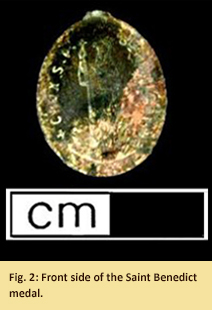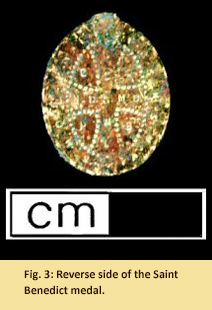Johnsontown (18CH778)
Introduction
The Johnsontown site (18CH778) is located on the south side of Spring Hill Branch in a level agricultural
field in Charles County, Maryland. The site is part of the "Johnsontown" tract, a 700-acre parcel
originally patented in 1661 by Daniel Johnson and William Morris. Johnson and Morris sold their
shares in the property to Francis Wynne; by 1665, the tract had been acquired by Henry Hawkins.
Hawkins had come to Maryland in 1665 as a free man along with his wife, Elinor, and son, John.
Hawkins and his family lived at Johnsontown until his death in 1699. Hawkins and Elinor had four
more children before Eleanor's death in 1681. Hawkins married Elizabeth Holland Wynne, the
widow of Francis Wynne, and together they had three more children. After Henry's death,
Elizabeth remained at Johnsontown until her death in 1717. The property was inherited by
his son, also Henry, who had previously relocated to "Faire Fountain" off Hawkins Gate
Road (Rivoire 1990).
Henry Hawkins was a prosperous planter and also a tanner. He held extensive landholdings, largely
acquired through purchase, and he also held various local offices, including that of sheriff and
justice. Hawkins also served in the Lower House of the Assembly after the overthrow of the Calvert
government. At his death in 1699, Hawkins owned 2,775 acres of land with a total personal estate
value of 327 pounds sterling, including three slaves and 11 servants (Archives Md. 426:424).
In 1685, court records indicate Hawkins held the following servants, all presumably of English
or European descent: Hannah Newman (age 11), George Kingsbury (age 19), John Brooke (age 21),
Elizabeth Coddington (age 14), Edward Sackimore (age 14), John Thompson (age 17), Jeremiah
Spurling (age 18), and Roger Yappe (age 21). Hawkins also had at least one Susquehannock
servant or slave working on his plantation in 1681. In that year, a raid by "Northern Indians"
took the Susquehannock man away from "where he was at worke in the Shopp" (Archives Md. 17: 20-21).
Archaeological evidence supports the interpretation that Elizabeth Hawkins remained at Johnsontown
until her death in 1717. The presence of white salt-glazed stoneware fragments, "dot, diaper, and
basket," suggest that the site was occupied until at least 1740.
Archaeological Investigations
The Johnsontown materials consist exclusively of a surface collection made by an avocational
archaeologist over the course of a number of years before 2008. Artifacts were not systematically
collected and patterns in their distribution can only be interpreted in a general way. In 2008,
a portion of the collection was loaned to the Maryland Archaeological Conservation Laboratory
and a catalog was prepared by archaeologists from St. Mary's College of Maryland (King, Strickland,
and Norris 2008). Since then, the owner of the artifacts has donated additional items to the
Maryland Archaeological Conservation Laboratory.
Artifacts
The cataloged portion of the Johnsontown collection is a rich assemblage of white clay tobacco pipe
fragments, including marked and decorated specimens, colonial ceramics, colonial glass, and a range
of artifacts generally described as "small finds." Nonetheless, users are cautioned that the materials
are probably not a representative set of material from the site.
Eight white clay tobacco pipe stems are marked with the initials of the pipemaker, including Llewellin
Evans (1661-1689), William Evans (1662-1692), and Robert Tippett (1678-1713/1720). Marks with the
letters "IP" (James or Jacob Prosser?) and "IF" (James/John Fox) are also represented in the assemblage.
The overwhelming majority of the ceramics – 132 out of 181 fragments – consist of German and English
stonewares. Other ceramics in the collection include tin-glazed earthenware, Staffordshire slipware,
and Manganese Mottled earthenware. Utilitarian wares include North Devon gravel-tempered earthenware,
Buckley ware, Border ware, and unidentified red-pasted coarse earthenware with a brown lead glaze.
One coarse earthenware fragment comes from a bowl that may have been made by Morgan Jones, a potter
who had a kiln in St. Mary's County and later on the south shore of the Potomac in Westmoreland County, Virginia (Kelso and Chappell
1974). Not a single sherd of Chinese export porcelain is present in the collection.
The ceramics recovered from Johnsontown represent a temporal span of occupation that began in the second half
of the 17th century and continued until at least 1740, although probably not much later. Rhenish
brown stoneware, Staffordshire slipwares with early style decorations, a fragment of lead-backed
tin-glazed earthenware, the possible Morgan Jones ceramic, and the decorative motifs evident on a
number of the Rhenish blue and gray stoneware sherds indicate a date of occupation beginning ca.
5 1670. This beginning date fits well with the dates provided by the makers' marks on the pipes.
The recovery of English brown stoneware, dipped white salt-glazed stoneware, and white salt-glazed
stoneware fragments indicate the occupation continued into the early 18th century. The white
salt-glazed stoneware fragments, however, exhibit a dot, diaper, and barley molded decoration,
a design not available until about 1740, suggesting the site was occupied through that date.
No Whieldon ware or creamware appears to have been recovered from the site, suggesting, on the
basis of the ceramic evidence, that the site was abandoned before mid-century.
Small finds include three lead shot, five glass beads,
one copper alloy buckle, two copper alloy bridle bosses, three copper alloy buttons, one pewter
button, two copper alloy leather ornaments, one copper alloy ornament with a light blue paste
jewel mounted in the center, one copper alloy tack, one lead weight, and one table glass fragment.
An especially interesting artifact in the Johnsontown assemblage is a copper alloy St. Benedict
medal. This especially small medal would have been worn on a rosary and may have been worn to
ward off sickness or evil. Although Hawkins and his family were Anglican, the medal could have
belonged to a servant or even to a member of the Hawkins family (Wingfield 2009).
 St. Benedict medal, front.
St. Benedict medal, front.
 St. Benedict medal, back.
St. Benedict medal, back.
References
King, Julia A., Scott M. Strickland, and Kevin Norris. 2008. The Search
for the Court House at Moore's Lodge: Charles County's First County Seat. Report prepared
for the Citizens of Charles County. St. Mary's City: St. Mary's College of Maryland.
Wingfield, Erin. 2009. Saint Benedict Medal.
http://www.jefpat.org/CuratorsChoiceArchive/2009CuratorsChoice/Feb2009-SaintBenedictMedal.html.
What You Need To Know To Use This Collection
Further Information About the Collection
The Johnsontontown collection is owned by State of Maryland and curated by the Maryland Archaeological
Conservation Laboratory. For more information about the collection and collection access, contact
Rebecca Morehouse, Collections Manager, at 410-586-8583; email
rebecca.morehouse@maryland.gov.
To Download Data
Data and a variety of other resources from this site are available for download. To download data,
please go to the Downloads page.